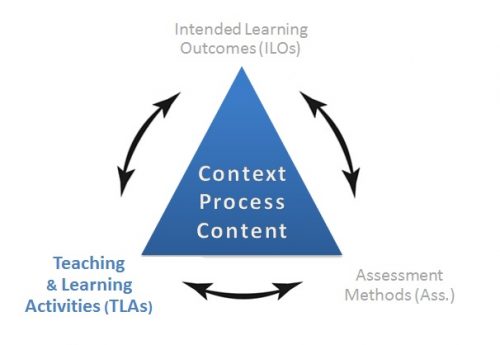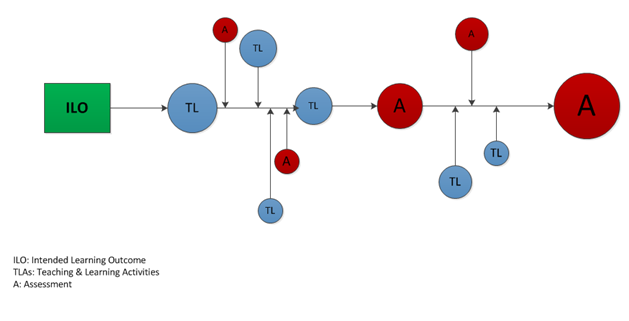Teaching & Learning Activities
Constructive Alignment is a framework to realise education in which intended learning outcomes (ILOs), teaching and learning activities (TLAs) and assessment (Ass.) are aligned. This implies that when (re)designing courses choices have to be made regarding these three aspects. This page intends to give a short, non-exhaustive overview of different instructional approaches that can be used to facilitate learning and assessment.
PBL Disclaimer
PBL at UM relates to four key learning principles: 1) constructive, 2) collaborative, 3) self-directed, and 4) contextual learning (Dolmans, 2005). Whereas the PBL-format used to organize the learning process, e.g. the 7-steps, is applied in various ways by various faculties, the key learning principles remain at the core of UM’s teaching and learning activities. This project takes into account PBL on the basis of these four key learning principles rather than on the basis of varying teaching formats.

A teaching method is appropriate if it enables students to practice exactly those skills or cognitive processes which they need to achieve the intended learning outcomes. Students will be more motivated as they perceive the activity as meaningful.
The videos below, based on J. Biggs’ Constructive Alignment theory, show how a teacher can make sure that all types of students learn what the teacher wants them to learn.
At the basis of the learning process lies the learning task. Van der Vleuten defines the learning task as follows:
”A learning task can be anything that leads to learning: a lecture, a practical, a patient encounter, an operation in the hospital operating theatre, a problem-based learning (PBL) tutorial, a project, a learning assignment or self-study. When arranged appropriately, these learning tasks in themselves provide a coherent programme or curriculum constructed in accordance with the principles of instructional design (…).” (Van der Vleuten et al., 2012).
A TLA should support the achievement of intended learning outcomes. Whether or not a TLA is suitable depends on the aim and should be evaluated in relation to other TLAs. Questions that should be addressed are:
- Is the TLA the right method to address the ILO?
- Does the TLA evoke the right cognitive processes?
- Is there sufficient time for students to process the TLA?
CoAl and the impact on teaching & learning activities
The following testimonial shows how a constructive alignment approach to teaching and learning activities increases the coherence between ILOs and teaching methods.
Mark Spigt, Programme Coordinator at FHML, describes why and how he changed education in his educational programme to make sure it is constructively aligned.
“Constructive alignment changed the way I looked at the bachelor program that I am coordinating; Biology and Health. Hopefully, the following example will make it clear how the theory changed the way we redesigned the curriculum.
Together with the module coordinators we determined the final competences (ILOs) for our curriculum, so “what should the students be able to do at the end of the curriculum”. For example, we decided that our students should be able: “To design and carry out an experiment accurately, so that the results can be reproduced.” In our ‘old’ curriculum there were several laboratory practicals/trainings. During these practicals, the students performed different measurements and wrote reports about these small experiments. However, these practicals were instructed through a clear manual that described which tests the students should perform and how they should do it.
One could call this “cookery book practicals”. But we figured that if we want to deliver students that can function independently in a laboratory, the students need to be able to make decisions on which tests to use, they need to carry out the measurements perfectly, they need to analyse the outcomes, and they need to critically reflect on the whole process to see if any issues or mistakes could be related to the outcomes. So we reckoned that if these ‘skills’ are actually desired, we first needed to get rid of the cookery book manuals. However, we could not expect a student to show independent experiment skills straight away, so we redesigned the whole series of practicals so that each element of ‘experimenting’ would be addressed over the course of practicals.
For example, they increasingly had to make their own choices in choosing the measurement tools or the statistical models for the analyses. Now we have a structured plan for the practicals and it is clear which ILOs are covered in each practical, so that in the end the student can function independently in a laboratory. So making the final ILOs very clear, automatically made us realise how to change the practicals.”
Based on the ‘1 on 1-development’ of ILOs, courses and assessment, the longitudinal development of ILOs should be taken into account. There is more complexity and development possible with ILOs that are addressed in multiple courses. Similarly, a test can assess multiple ILOs. The figure below shows the effect of the longitudinal integration of ILOs/teaching and learning activities (TLAs)/ Assessment (Ass.)in a curriculum.

